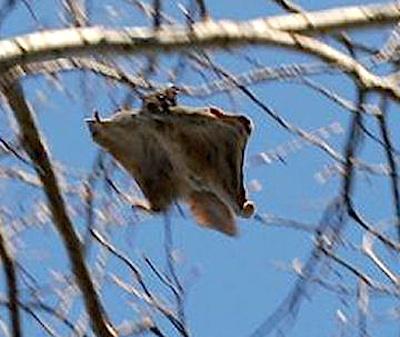Humans weren't the only ones stocking up for a feast this month. Flying squirrels, which call a number of national parks home, have been busy with their own meals with winter coming.
Due to their highly developed sense of smell, flying squirrels can easily forage for food during the night. Their diet consists primarily of fruits, nuts, fungi, and bird eggs. Flying squirrels are omnivorous and alter their diets based on the environment that surrounds them.
Now, before we go too far, it's important to point out the types and range of flying squirrels. In the United States, they basically are divided into two species: the northern and the southern flying squirrel. Northern flying squirrels (Glaucomys sabrinus) tend to be larger, however their coloration is similar to that of the southern flying squirrel (Glaucomys volans). Other than through DNA testing, it is very challenging to tell the difference between the two. It also should be noted that the northern flying squirrel has been designated an endangered species due primarily to human impacts to their habitat, while the southern version seems to be doing fine.
In general, these rodents are found, or have been found, in quite a few areas of the National Park System from coast to coast. The northern squirrel is very common in the Pacific Northwest and typically found in central part of the country, in Michigan and Wisconsin, though rare in Minnesota. It's also seen in the east from Maine south to North Carolina and Tennessee. And there also have been sightings of these squirrels in the Black Hills of South Dakota and extreme northeastern Wyoming, the Rocky Mountains, and even the Sierra Nevada.
There are many things that make the flying squirrel a unique species among all others. For instance, flying squirrels are the only species of nocturnal tree squirrels, which works to their benefit since they are unable to fight off many predators that hunt during the day. Their preferred habitat includes coniferous and mixed forests, and areas of good tree cover. Occasionally they will den in houses or barns, however they tend to avoid areas where wood has recently been harvested.

The northern flying squirrel is endangered. USFWS photo.
These little rodents are typically just 9-14 inches long, making them the smallest of all species of squirrels. They are easily identified by their large eyes and flattened tail with a whitish coloring of the fur underneath. The "patagium" is a furry, parachute-like membrane that stretches from wrist to ankle.
Although the name “flying squirrel” suggests that these mammals fly, they actually glide anywhere between 80-150 feet at a time using the skin flaps between their legs. Their midair speed varies as they change the position of their arms and legs, which are controlled by small cartilaginous wrist bones. Meanwhile, the squirrel's fluffy tail is responsible for stabilizing balance in flight, while also working as an air brake before landing.
Wild flying squirrels have a life expectancy of six years, however, zoo-kept flying squirrels can live up to 15 years. The mortality rate of wild flying squirrels is so much higher due to disease and predators, which can include tree snakes, raccoons, owls, coyotes, bobcats, etc.
A Rapid Life Cycle
If only they were active during the day time, you might expect to see a plethora of flying squirrels gliding through the hardwood forests during their mating season between the months of February and March.
Once born, infant squirrels stay in tree cavity nests with their mothers until they are ready to leave, while males do not participate in raising their offspring. At birth, flying squirrels look significantly different than their parents: hairless and lacking most of their senses. But they grow relatively quickly. At approximately five weeks old, they are ready to practice gliding. It takes about two months of “training” before they are ready to leave their nest and fend for themselves.
National park travelers can find flying squirrels in a variety of different places. They are very common in Olympic and Mount Rainier national parks in the Pacific Northwest, though rare in North Cascades National Park. They also are considered to be common residents of Yosemite National Park, but uncommon in nearby Sequoia and Kings Canyon national parks, as well as at Yellowstone National Park, according to the National Park Service.
You might catch sight of them -- if you're lucky -- in Eastern parks such as Acadia where the the northern flying squirrel is common; possibly Shenandoah, where the southern flying squirrel is considered a native but uncommon these days; the Blue Ridge Parkway, where the northern version is rare while the southern version is common, and; Great Smoky Mountains National Park, where northern flying squirrels also are rare while southern flying squirrels are common.
If you’re ever out at night in the parks or find yourself hiking in the fading light of sundown, be sure to keep an eye out for these fascinating little creatures.
Maggie Gonsiewski is an intern for the Traveler. She is a sophomore at West Virginia University pursuing a degree from the Perley Isaac Reed School of Journalism. She and her family have taken multiple roadtrips to many of America's national parks since she was very young, trips that definitely contributed to her love for outdoor adventure.




Comments
I saw one in Kings Canyon, which is near Sequia National Park, it was about 4 or 5 years ago.